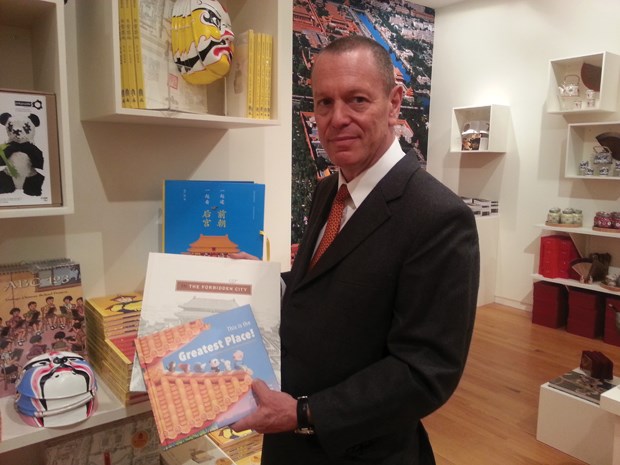Bridges crossing a physical divide can be built out of a variety of materials: wood, steel or concrete.
But one linking a gap between peoples and their disparate cultures? What would that use?
Try one constructed using children’s books. That’s the thought behind an exhibit at the Vancouver Art Gallery, a book unveiling at the Vancouver Public Library, and a one-day workshop today (Oct. 17) for students at Richmond’s McNeely elementary school, which all falls under the title We All Live in the Forbidden City.
At its core it features a series of books written to convey to youngsters the Chinese culture in a way that is compelling and would interest them, explained Ted Lipman, a former Canadian diplomat and current CEO of The Robert H. N. Ho Foundation which undertook publishing the books, which were initially released several years ago in mainland China using traditional script.
Two books will be launched this Saturday at the Vancouver Library which have been translated into English.
But why promote this now?
The exhibit is intended to address a growing need — and demand — from Western audiences to understand Chinese culture, the Chinese language, its arts and architecture, Lipman said.
While it is written as a child’s book, the intent is for it to have broad appeal.
And given the ethnic makeup of the Lower Mainland, it is expected to draw plenty of interest.
According to Statistics Canada data, 18 per cent of the roughly 2.5 million people in Metro Vancouver are ethnic Chinese.
In Richmond, that figure is much higher with residents of Asian heritage accounting for close to 60 per cent of the local population.
“Today, I think we all need to know what’s going on in China, Lipman said. “Not just now, but to understand and get some insights into Chinese culture, and I think that’s what these books do very effectively.”
Greater information about where a culture came from — its arts, culture and architecture — can promote better understanding and appreciation, and help pave a better way to the future, said Olivia Chen, an actress and former Entertainment Tonight Canada correspondent who is helping host the book launch.
Richmond city counillor Chak Au said he is supportive of initiatives bridging cultures and liked the concept of the Forbidden City book series.
“It’s very important to have common understanding of different cultures in order to live in a harmonious way. And it’s a good thing that they are trying to promote intercultural understanding through some creative ways,” said Au who is originally from Hong Kong and came to Canada in 1988. “This will be very interesting for young children who will not only get some understanding of Chinese history, but be prepared for the opportunities available to them in Asia in the years to come.”
Au said business activity in that region of the world is vibrant and is expected to offer coming generations increased ties with Canada.
“To have this kind of knowledge and background in Chinese history will only help them in the future in terms of jobs and careers,” Au said. “This can serve as a definite advantage.”
Au added the Ho family, is well respected in Hong Kong and Macau and has a history interracial marriage which helps explain their motivation in publishing the books.
“I think that’s an important point because I don’t want people to think that this is again, a Chinese family trying to promote their culture.”
Also supportive of the cultural bridging concept is Henry Beh, executive director of the Richmond Chinese Community Society.
“Anything about cultural exchange through our school children and education system is always good,” said Beh who is originally from Malaysia, studied Chinese history in school and visited the Forbidden City in Beijing several years ago.
Beh said using the history of the Forbidden City as a place no commoner was allowed enter is an interesting juxtaposition given the efforts to open the door wider on the Chinese culture to the rest of the world.
The Forbidden City: Inside the Court of China’s Emperors runs Oct. 18 to Jan. 11, 205 at the Vancouver Art Gallery. Visit vanartgallery.bc.ca and click on the What’s New section for more information about the exhibition.



